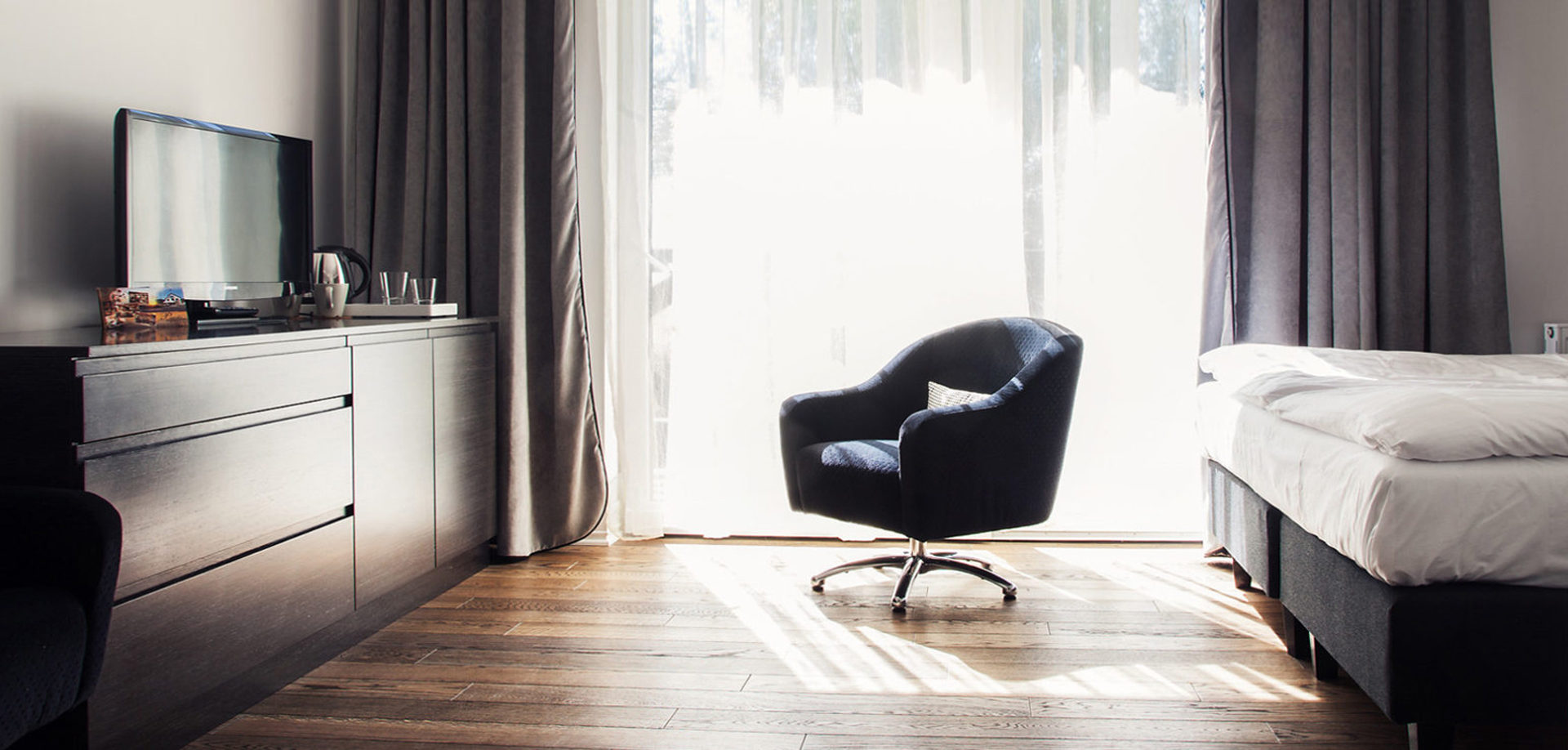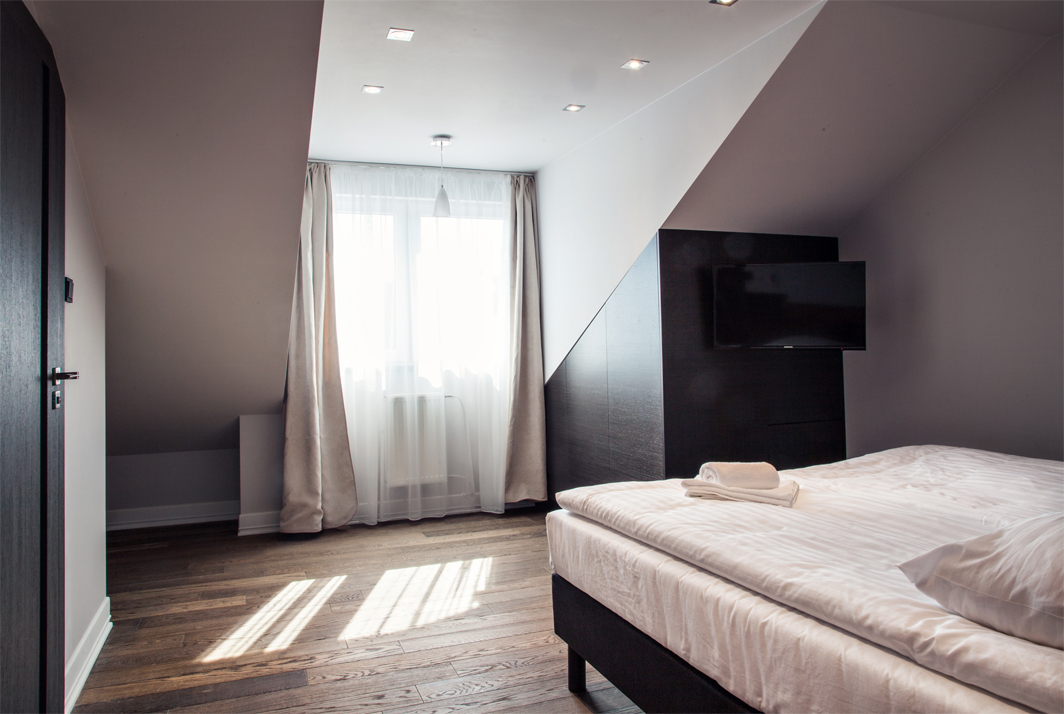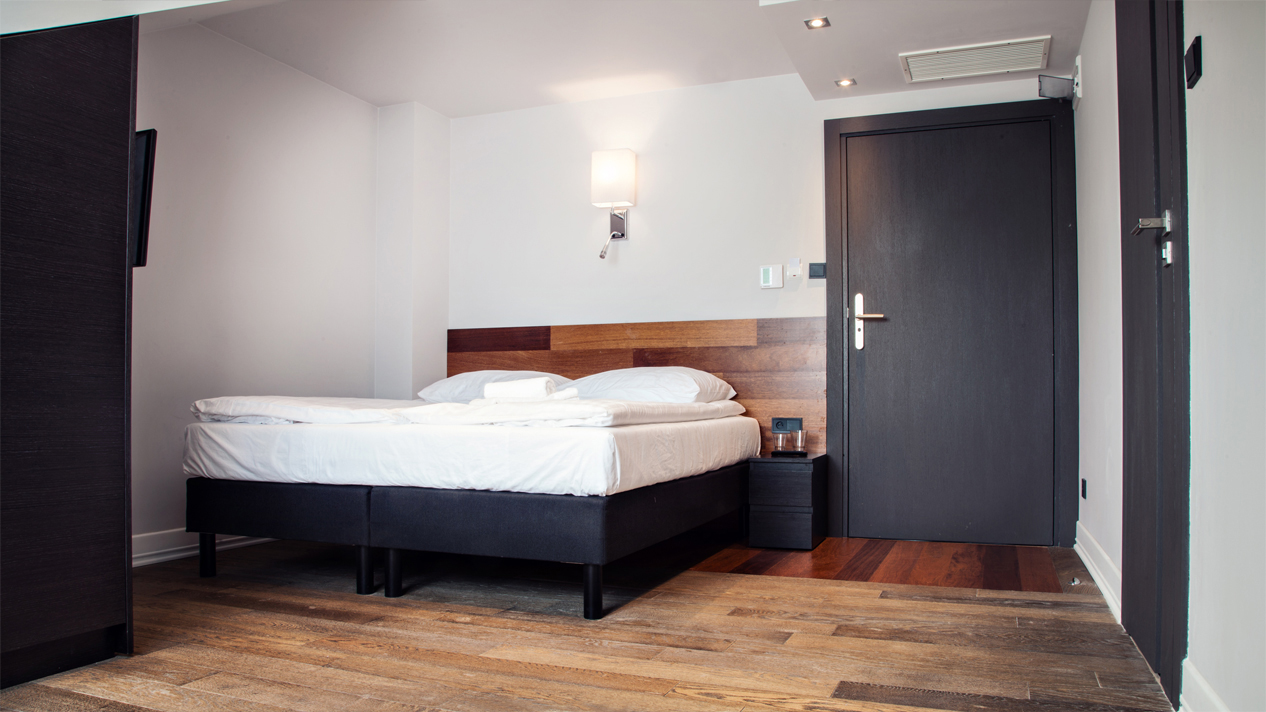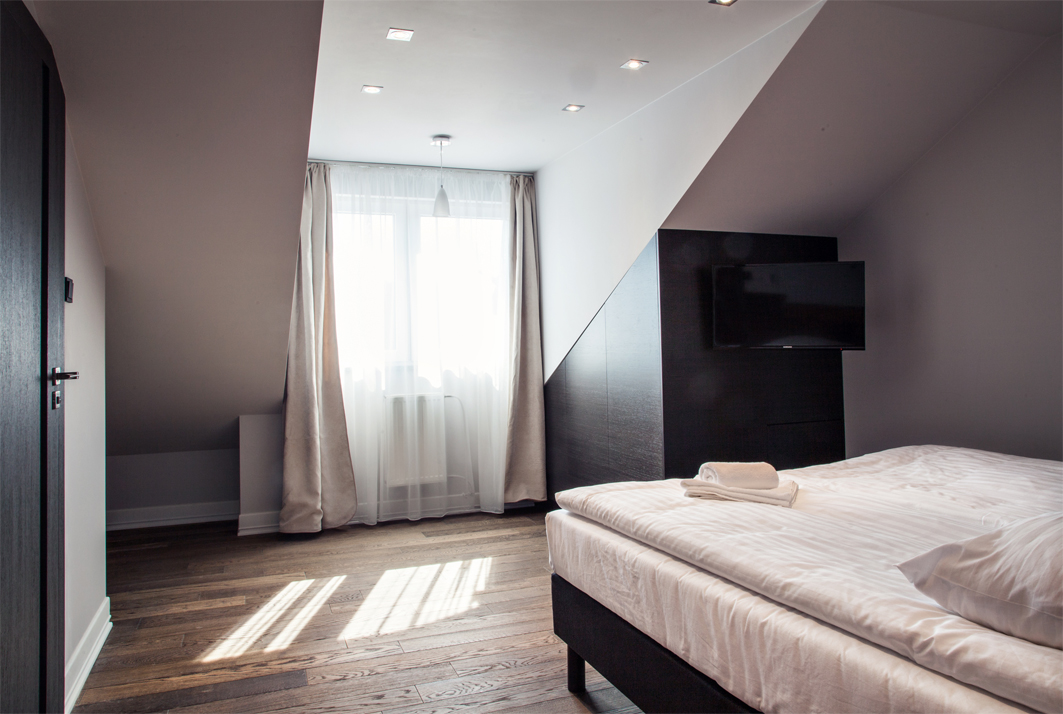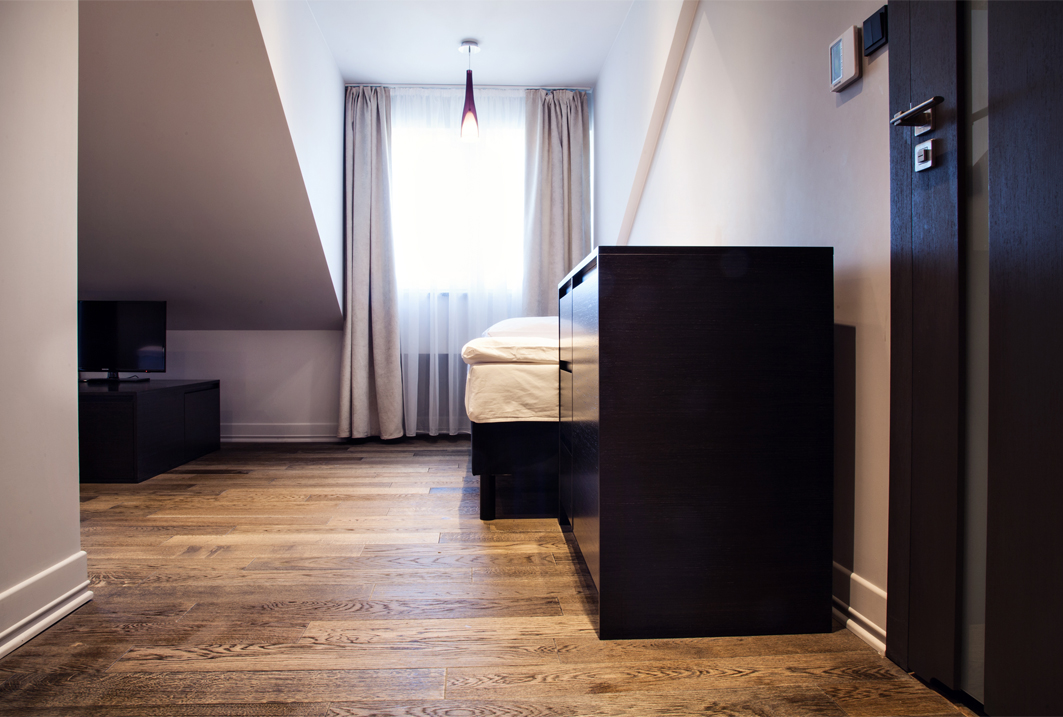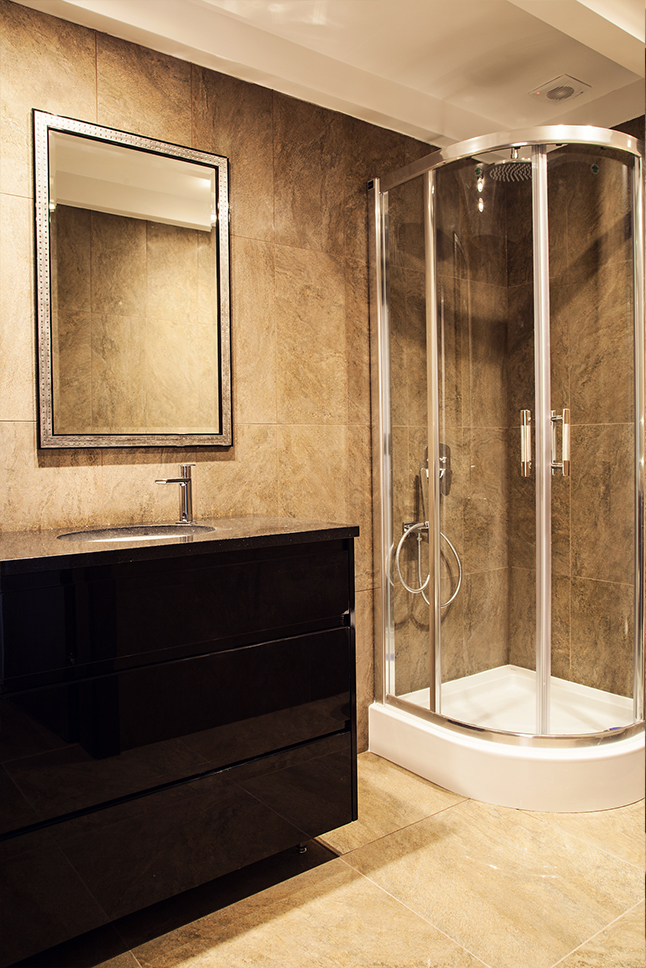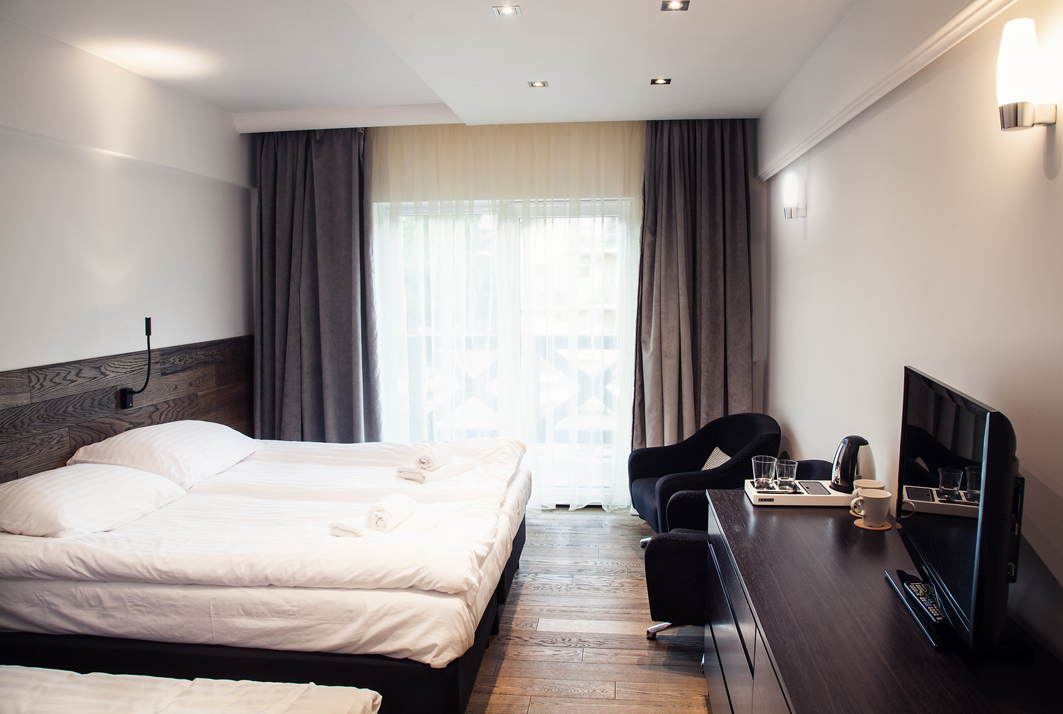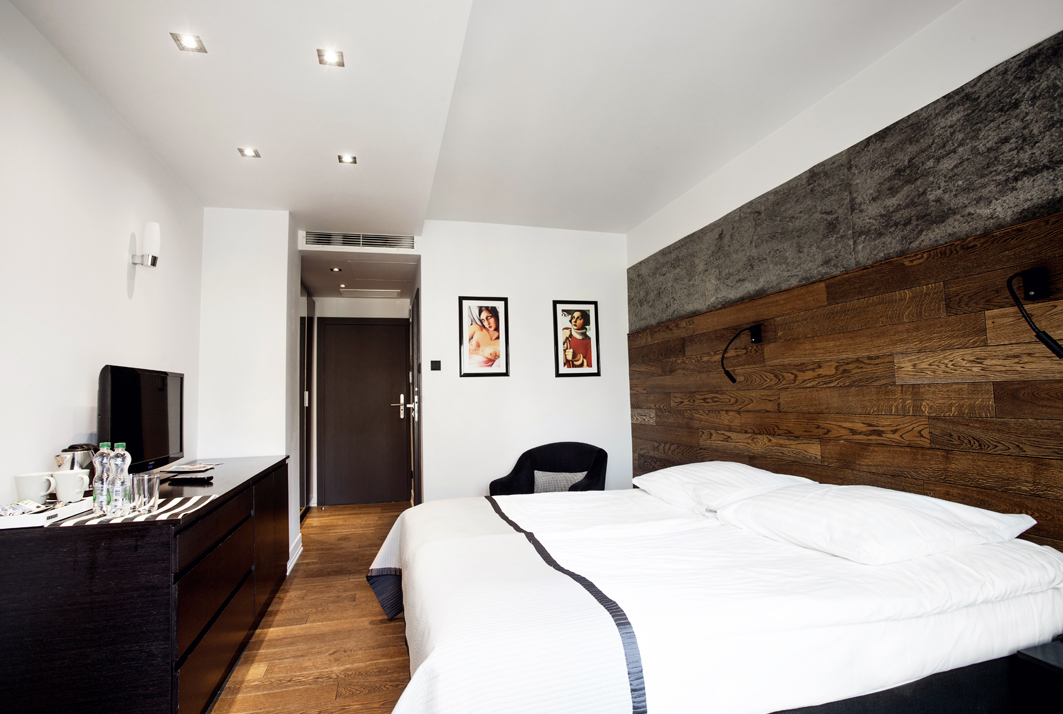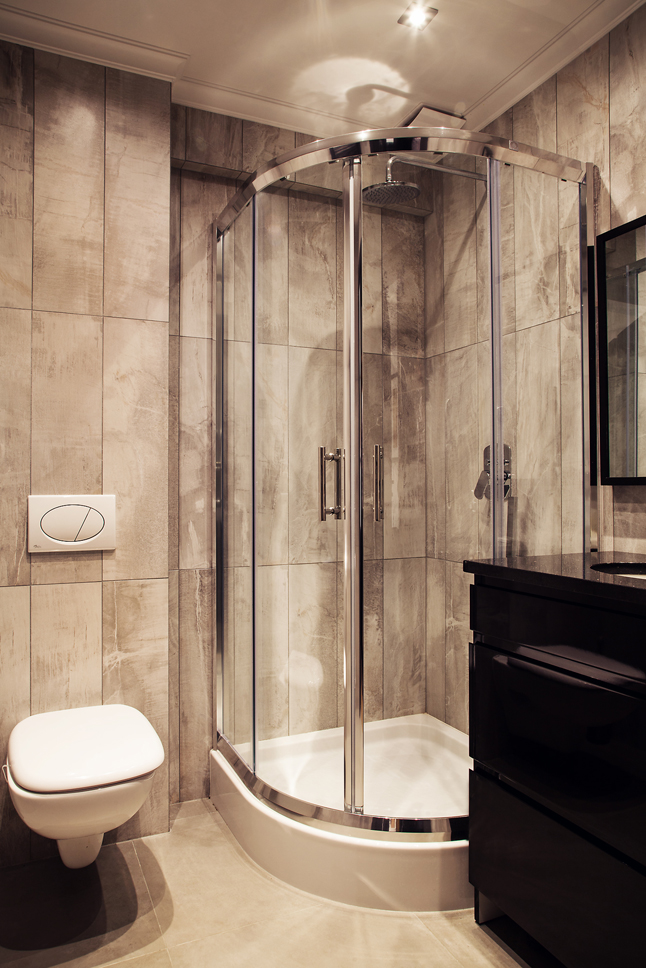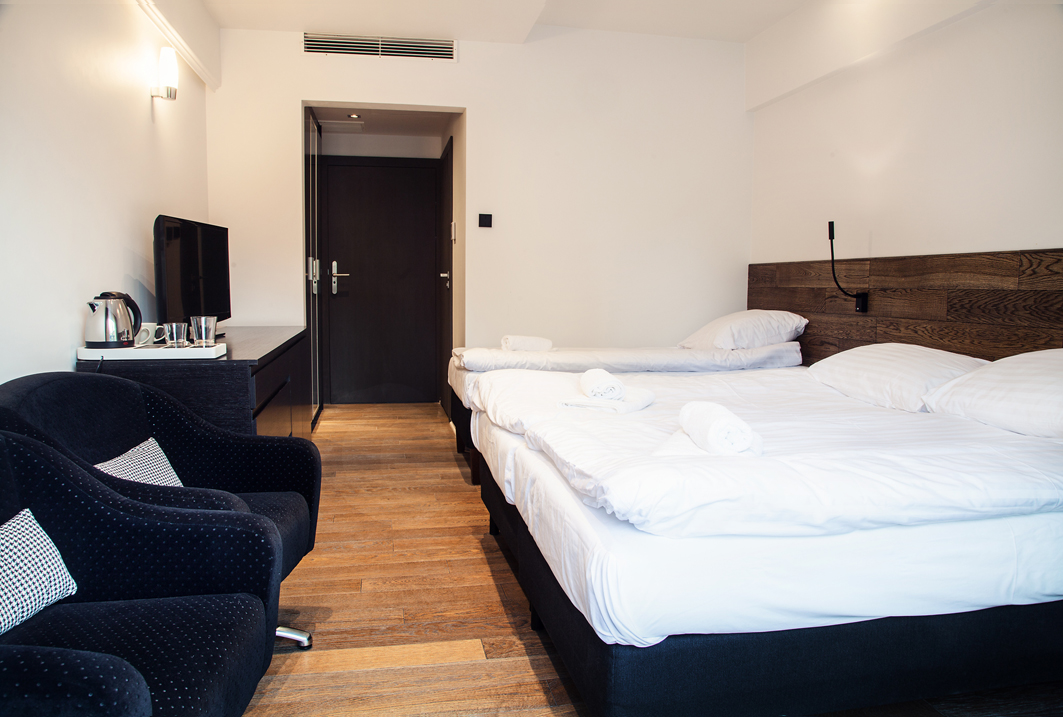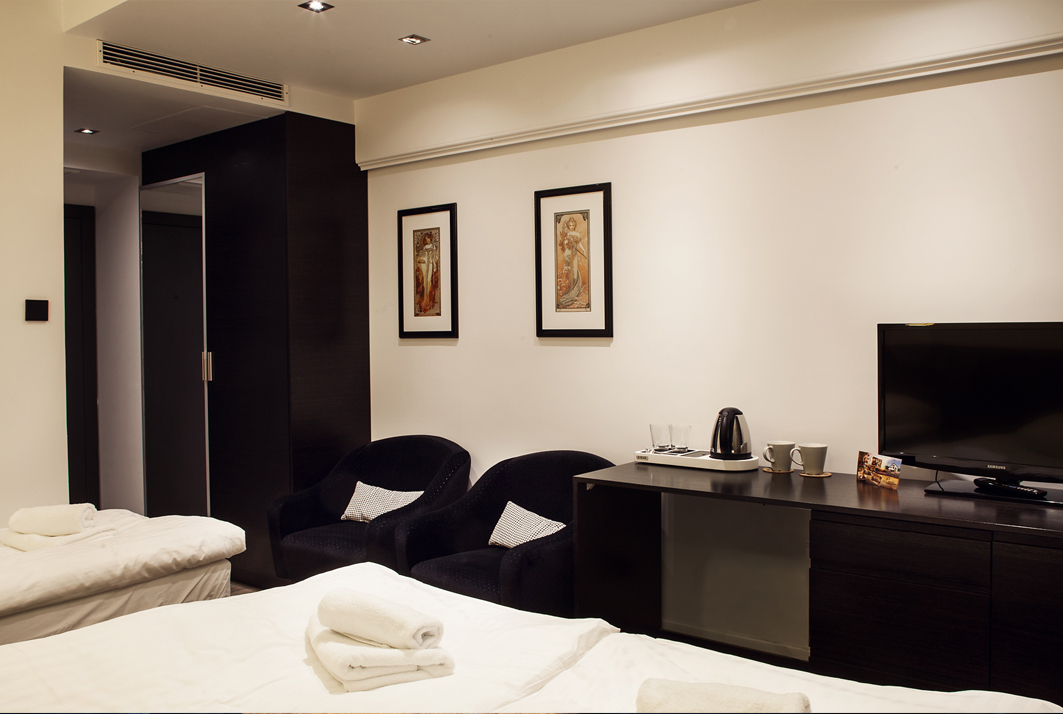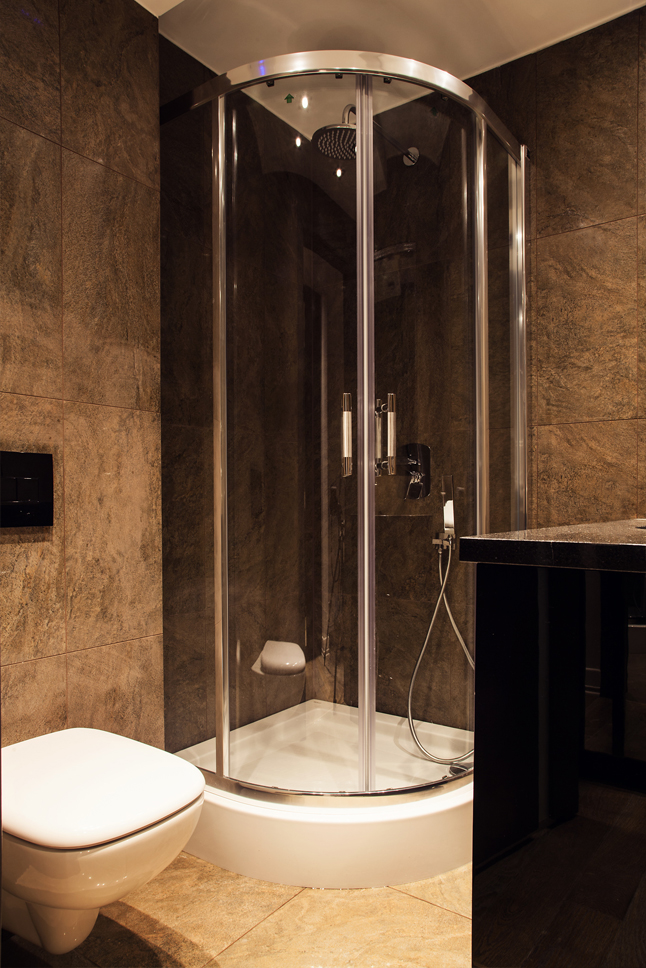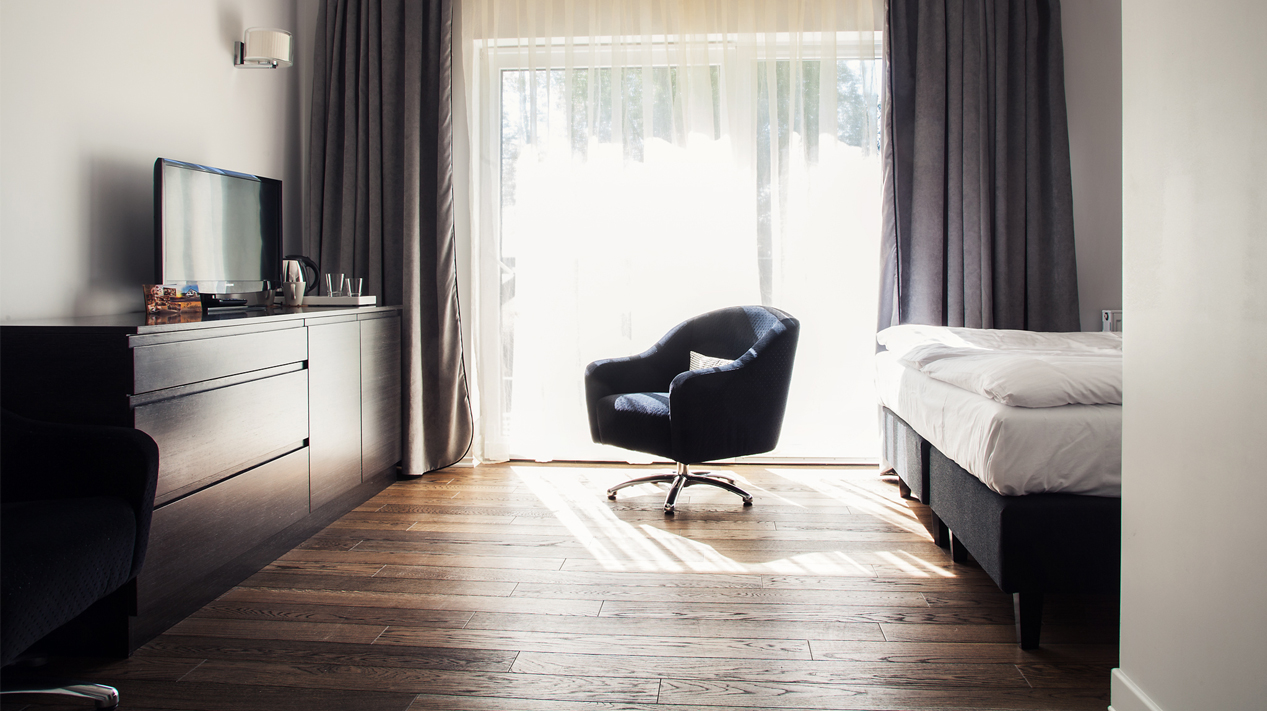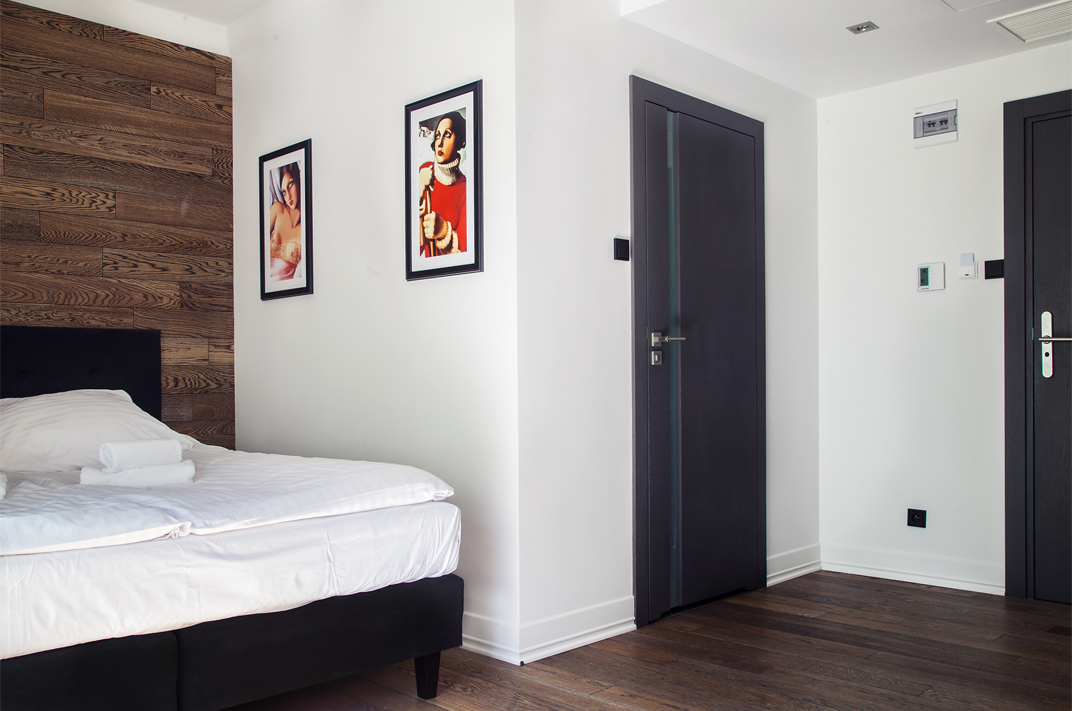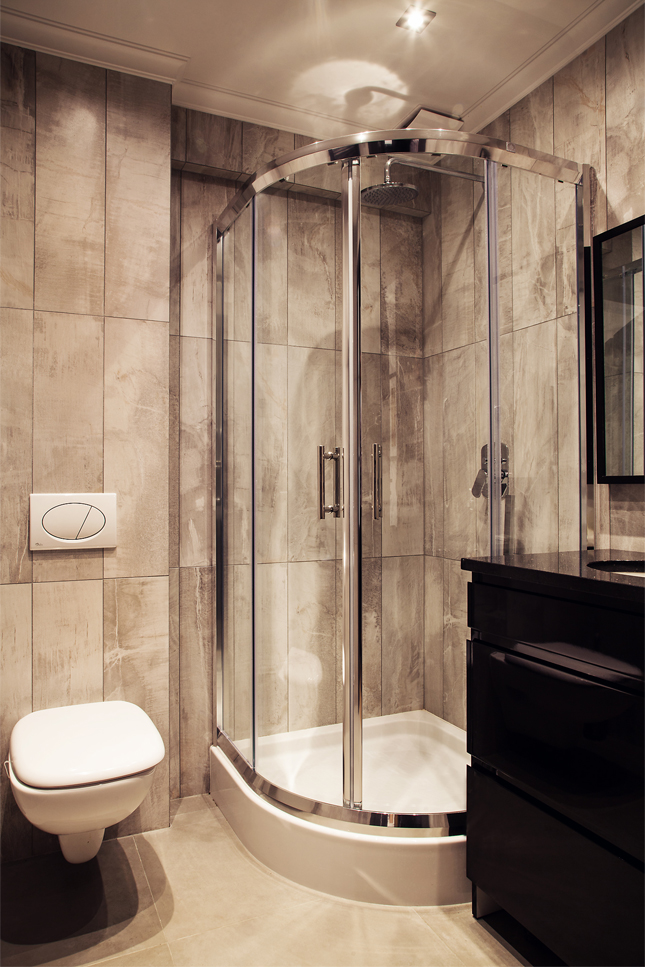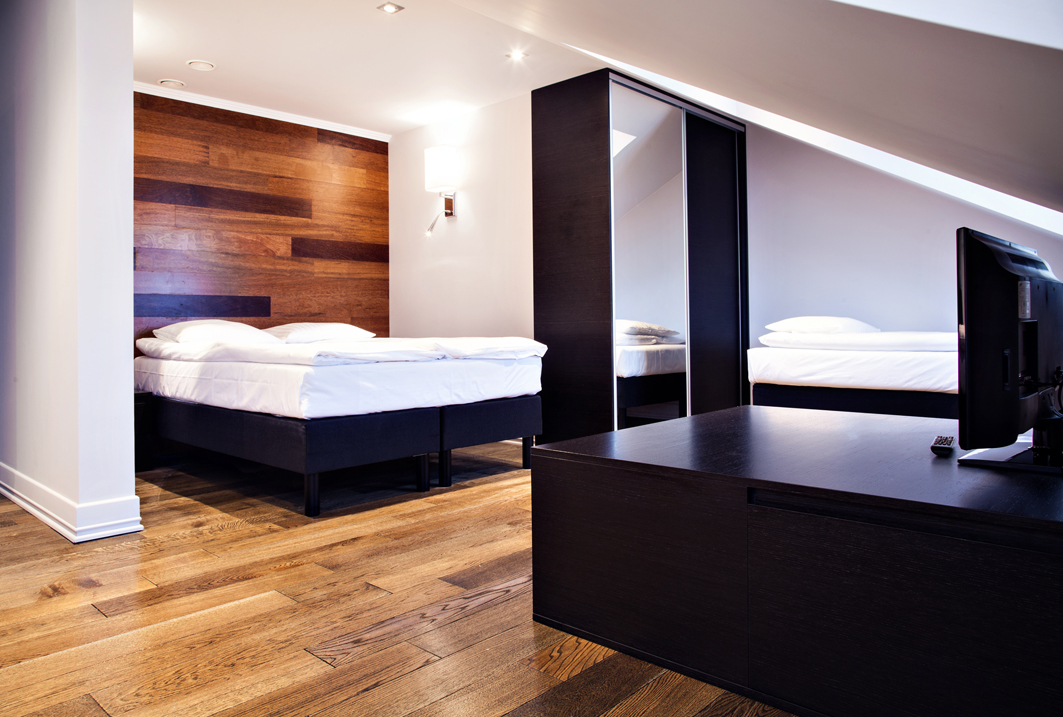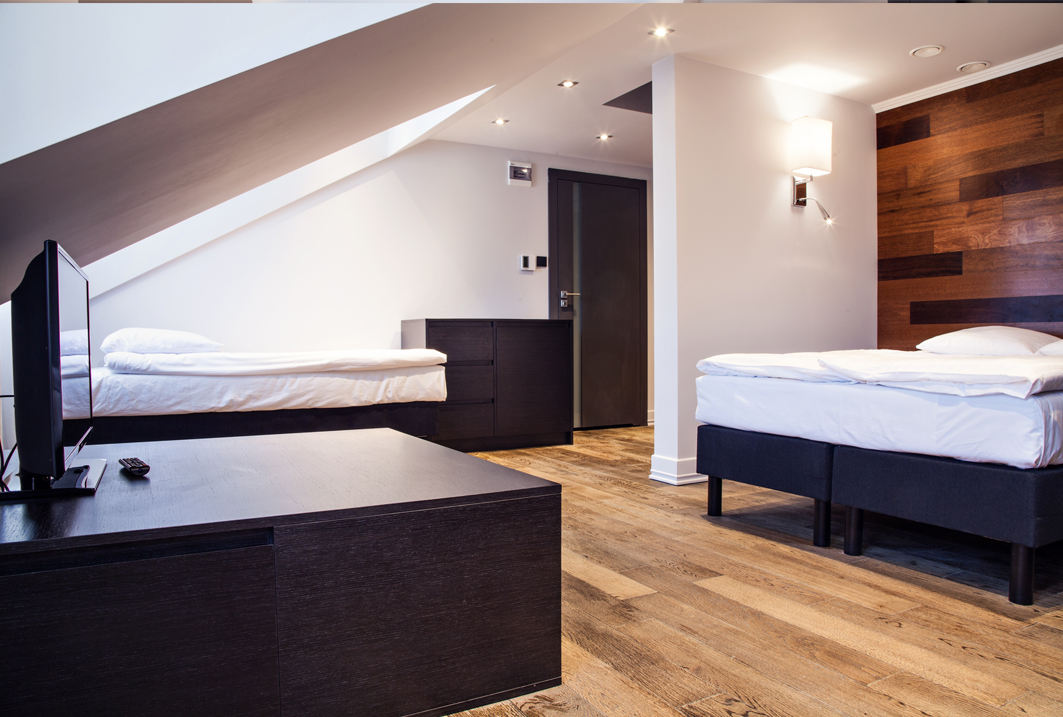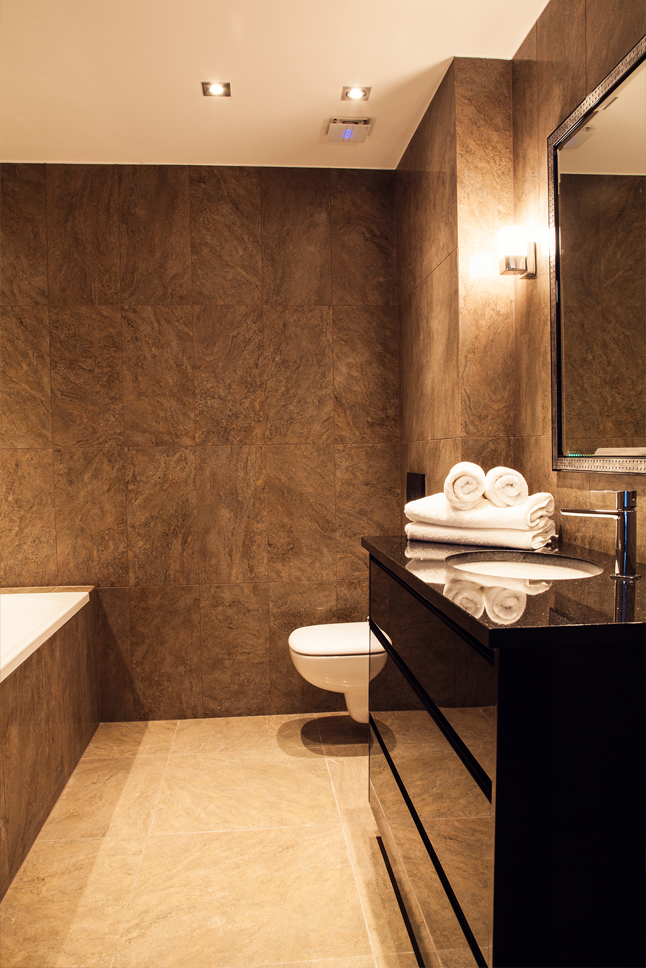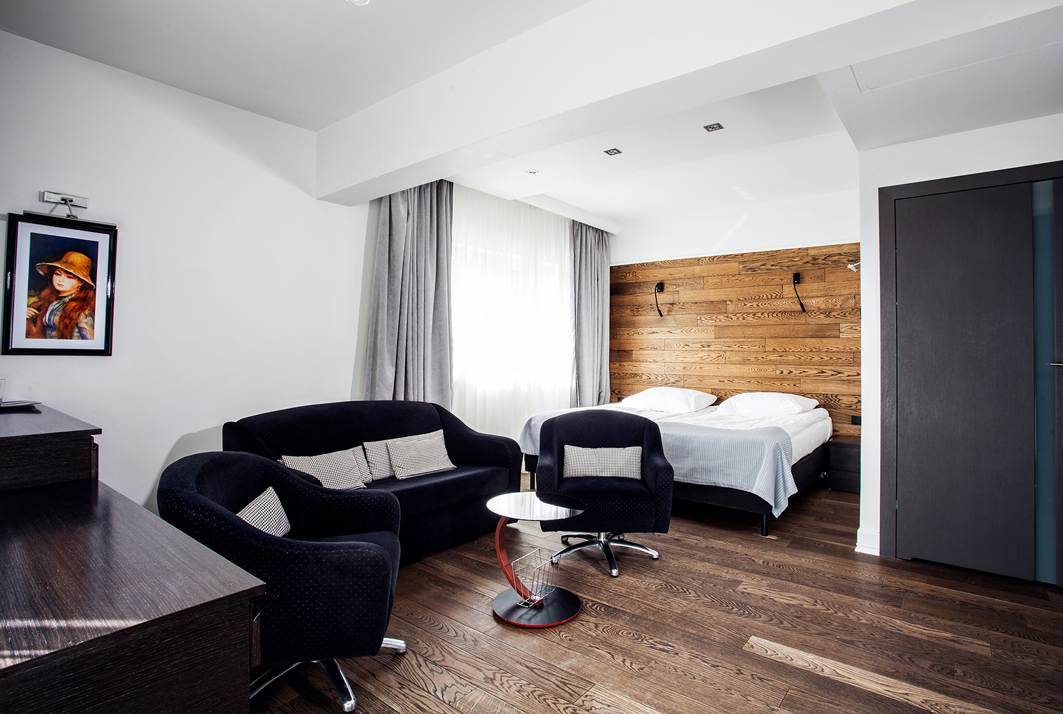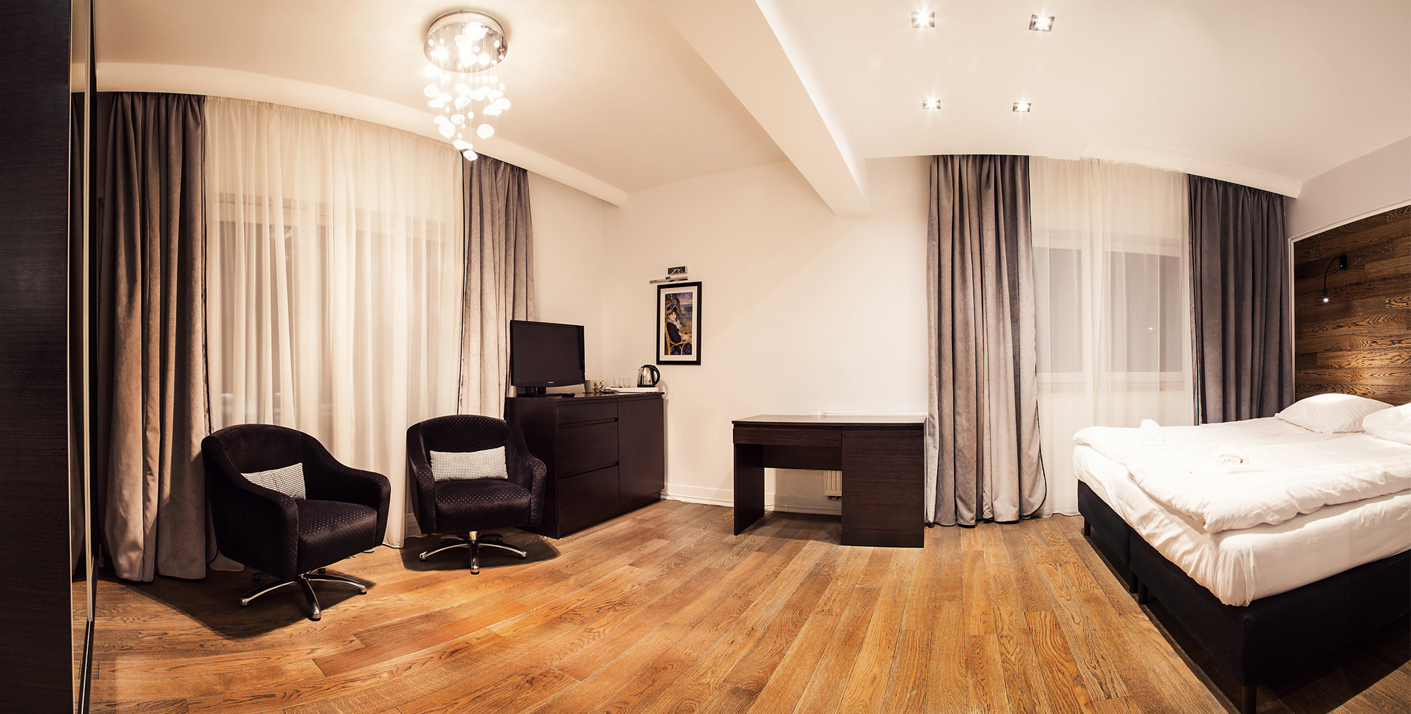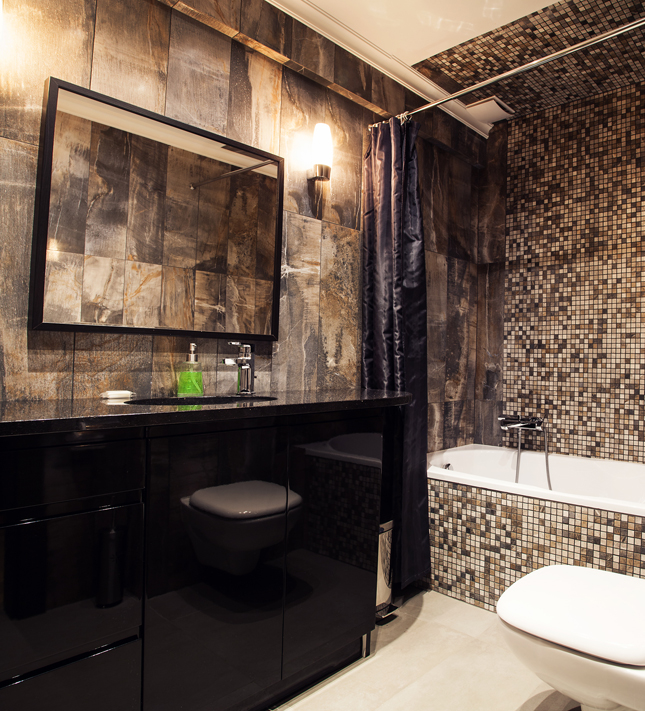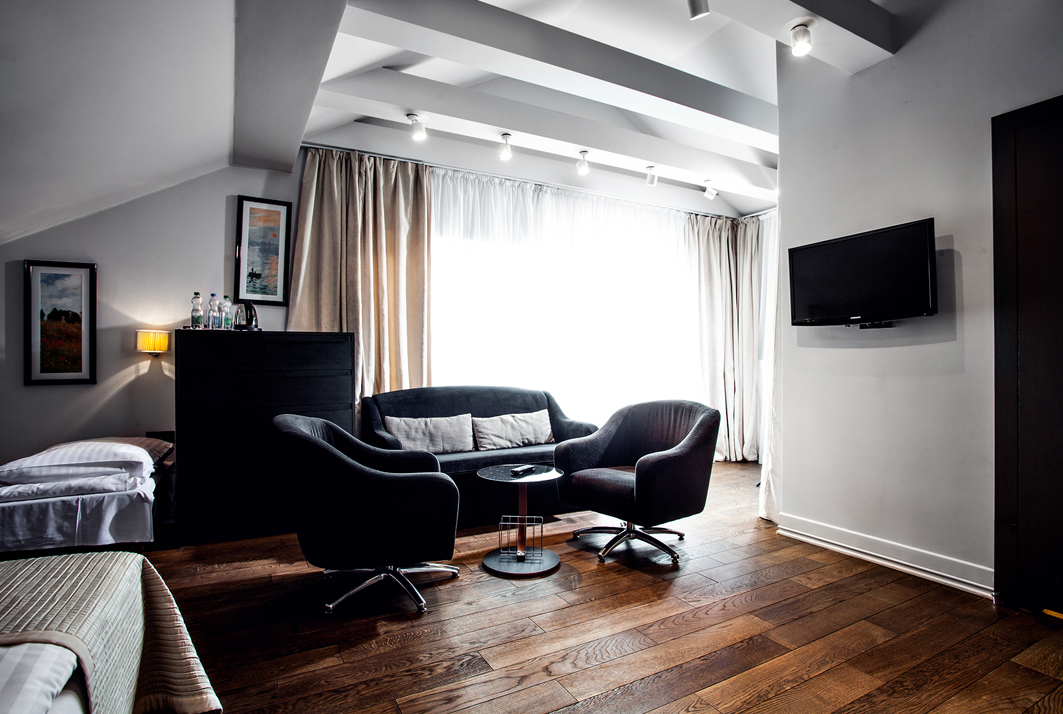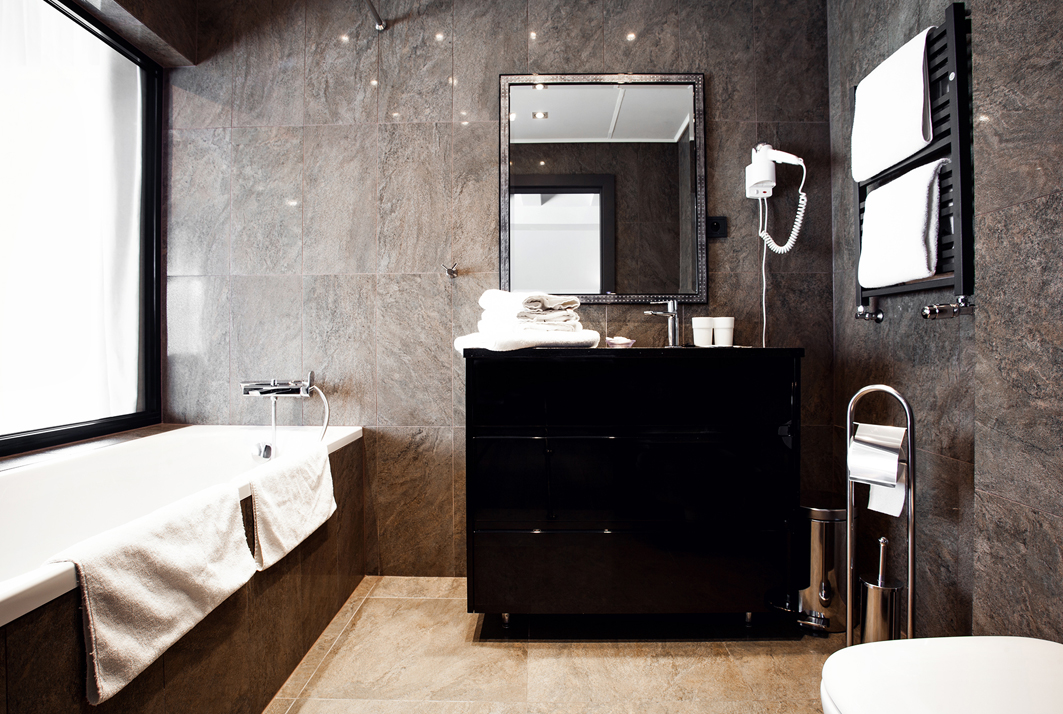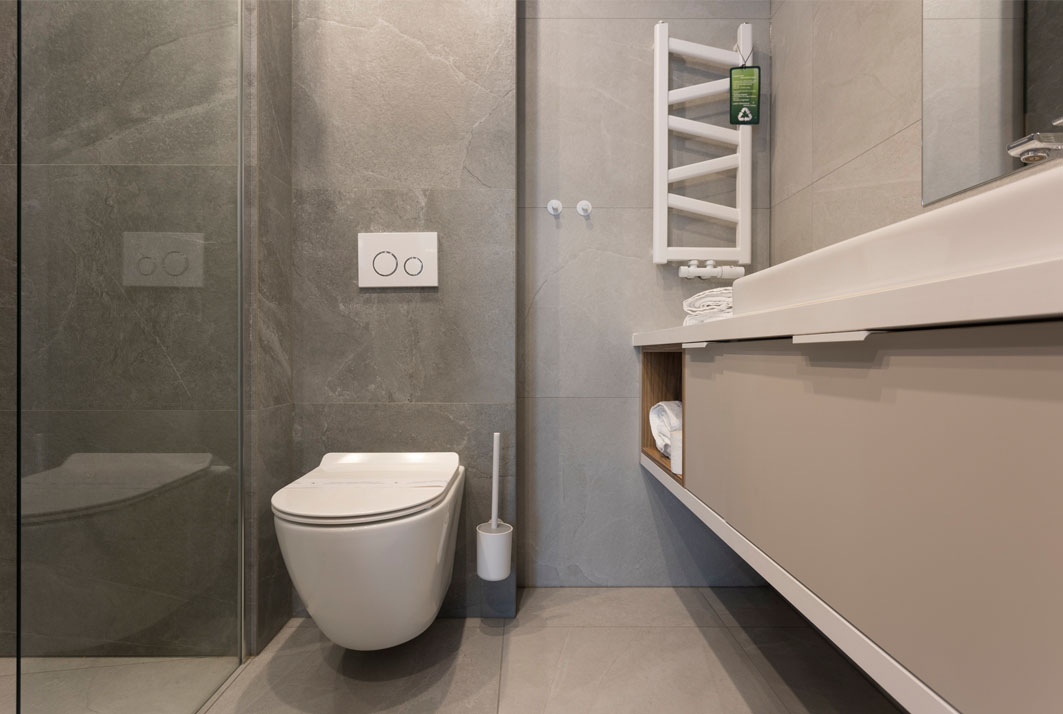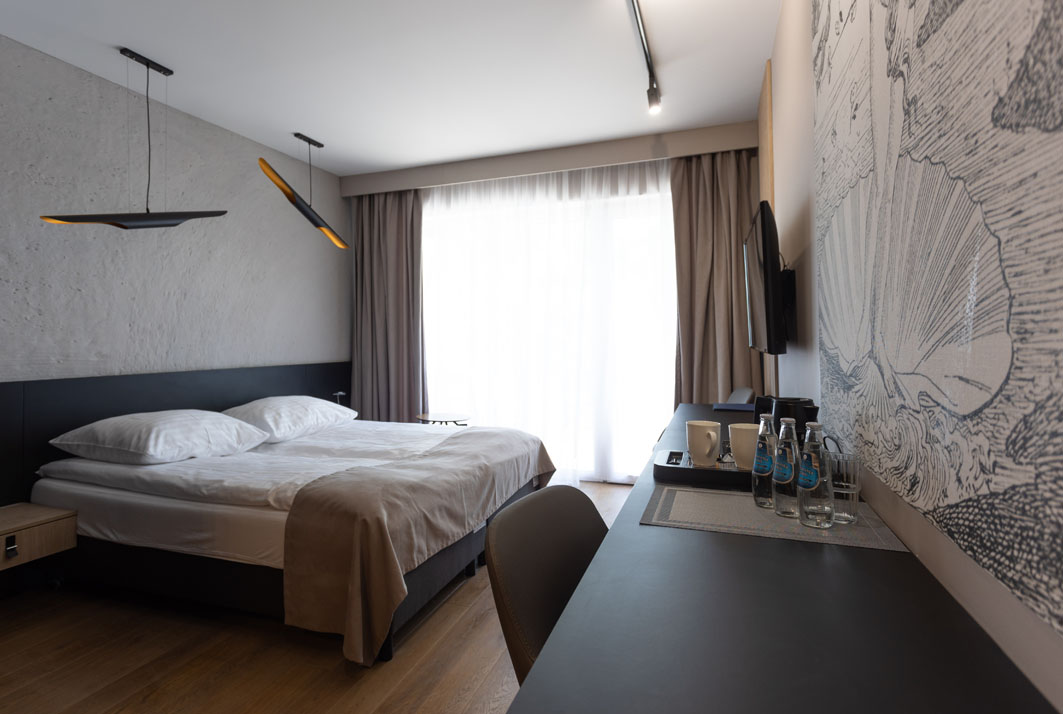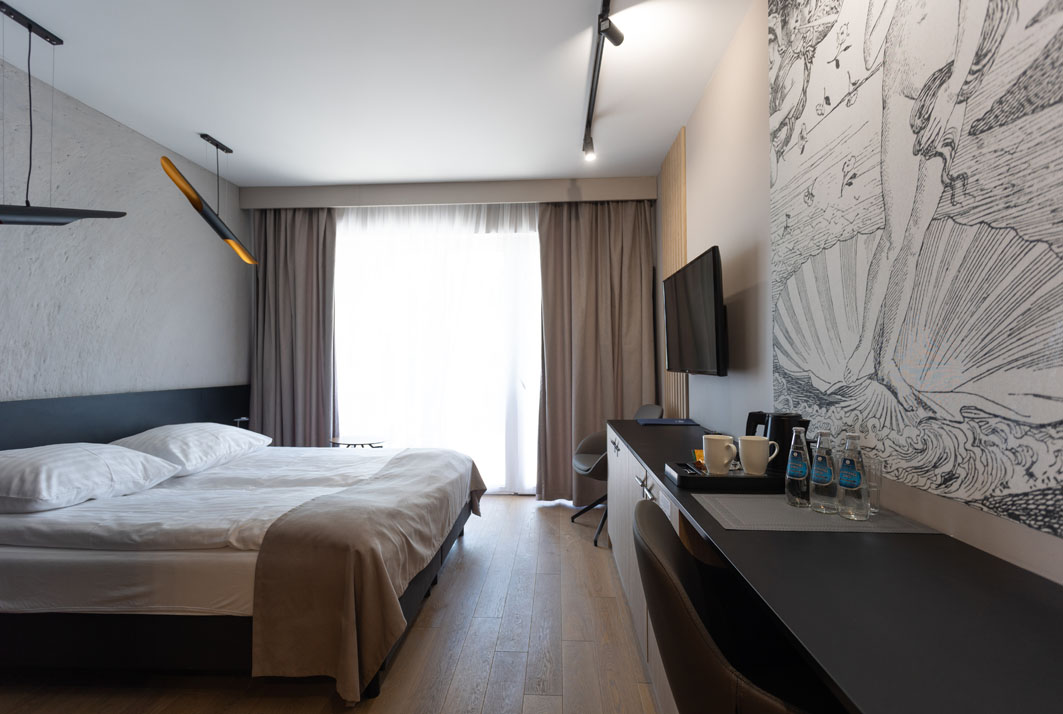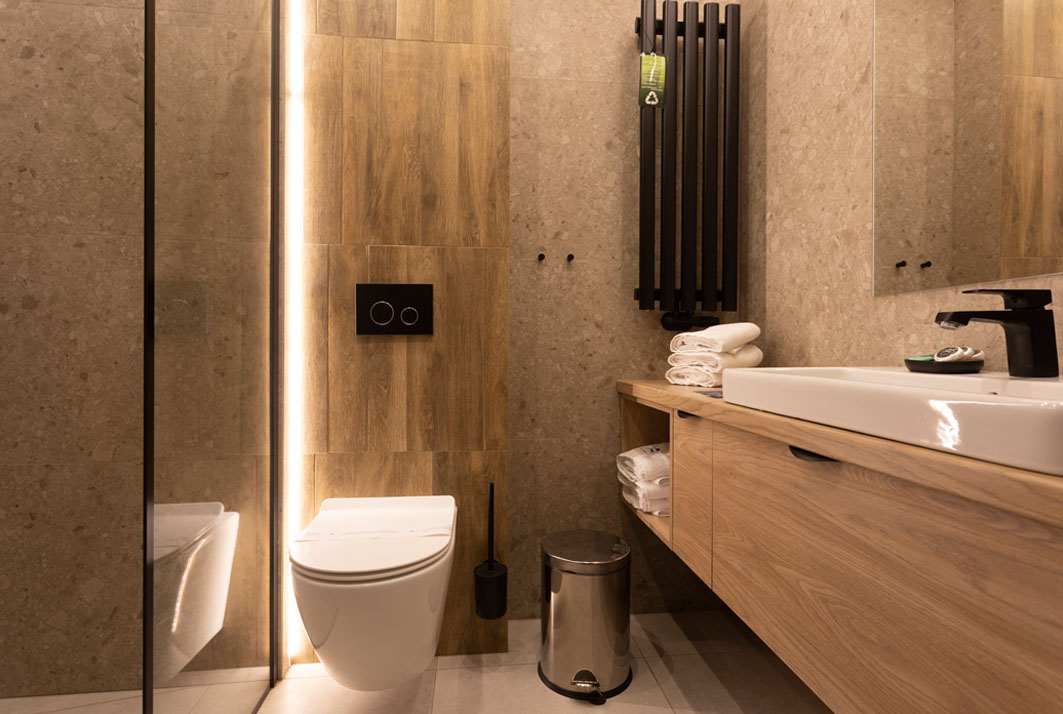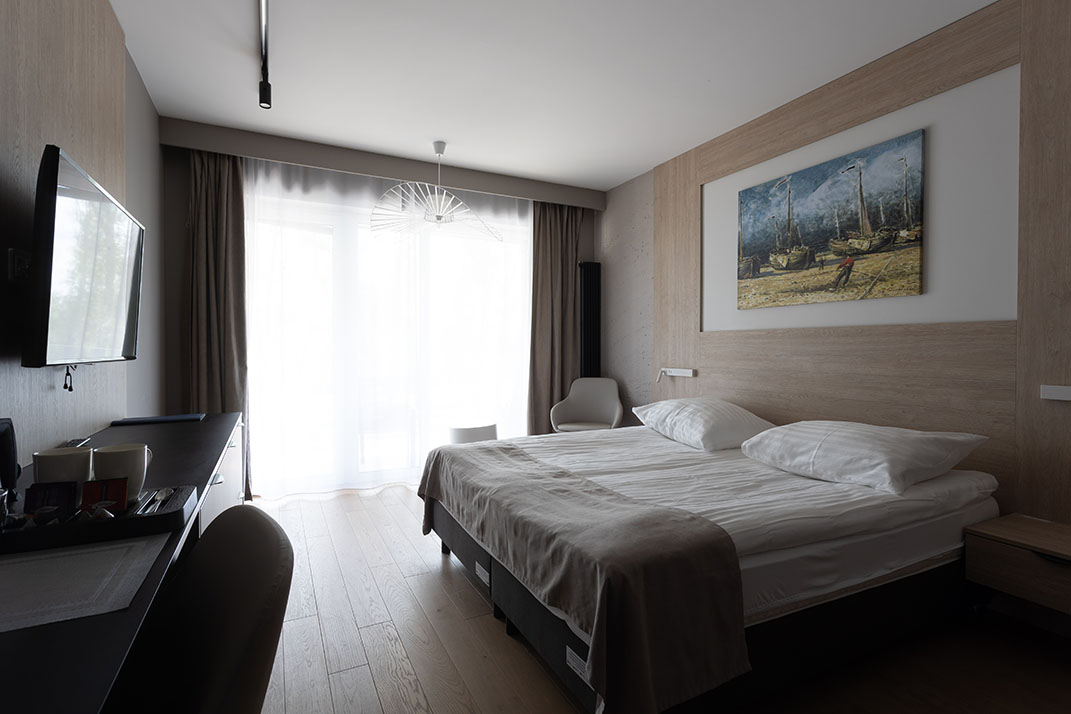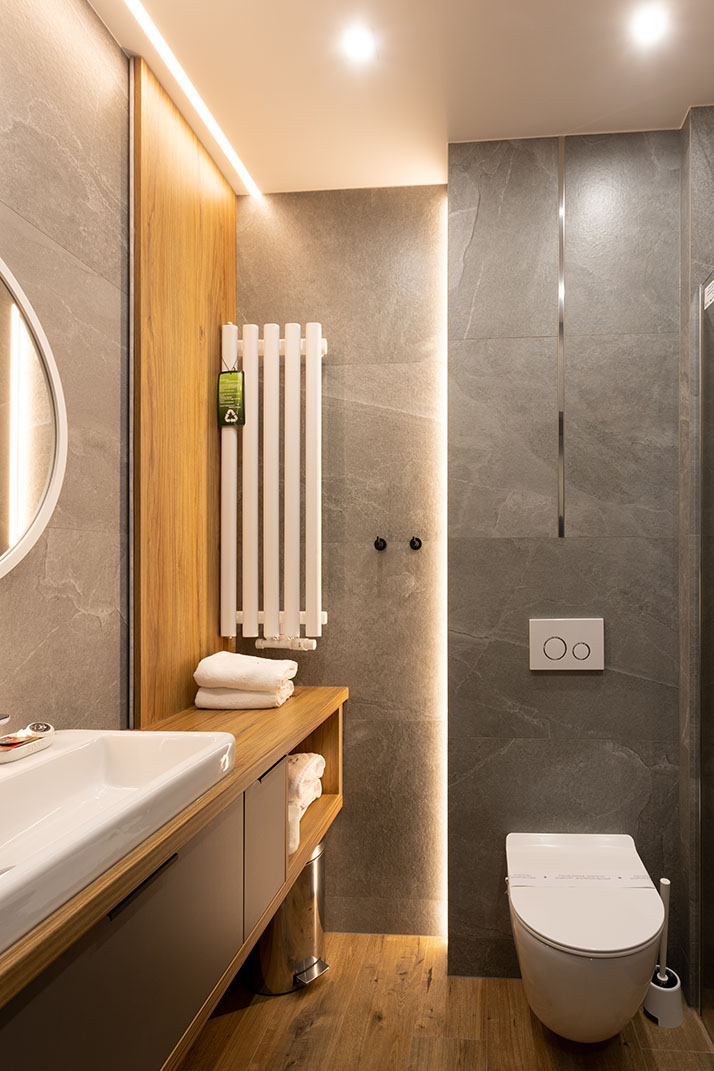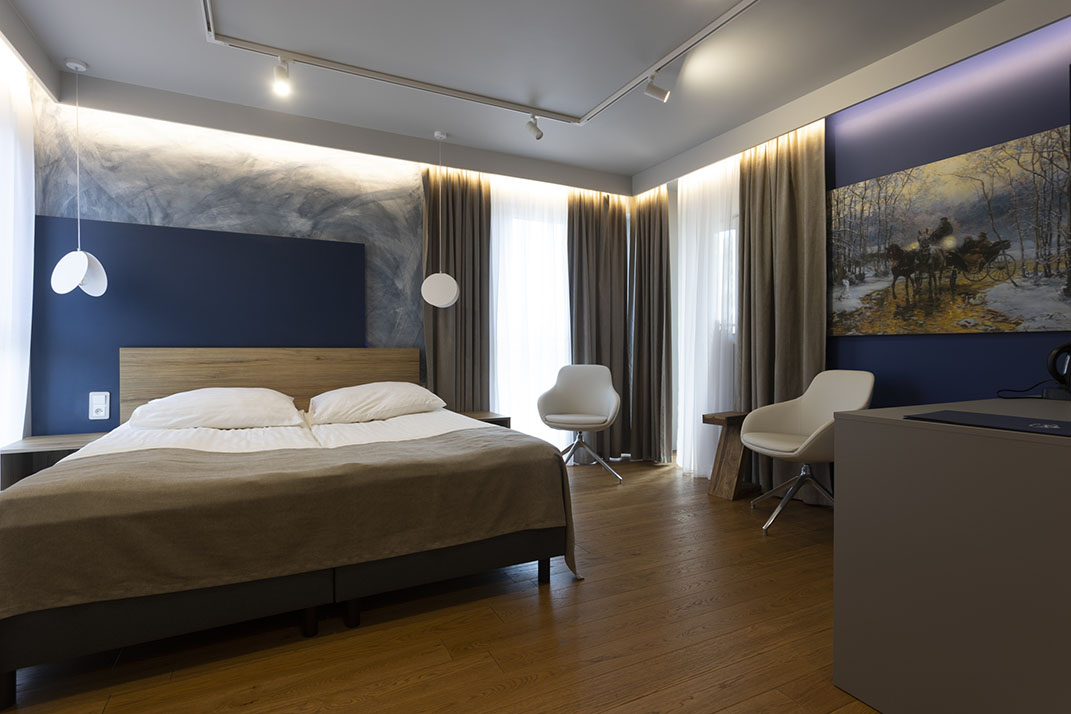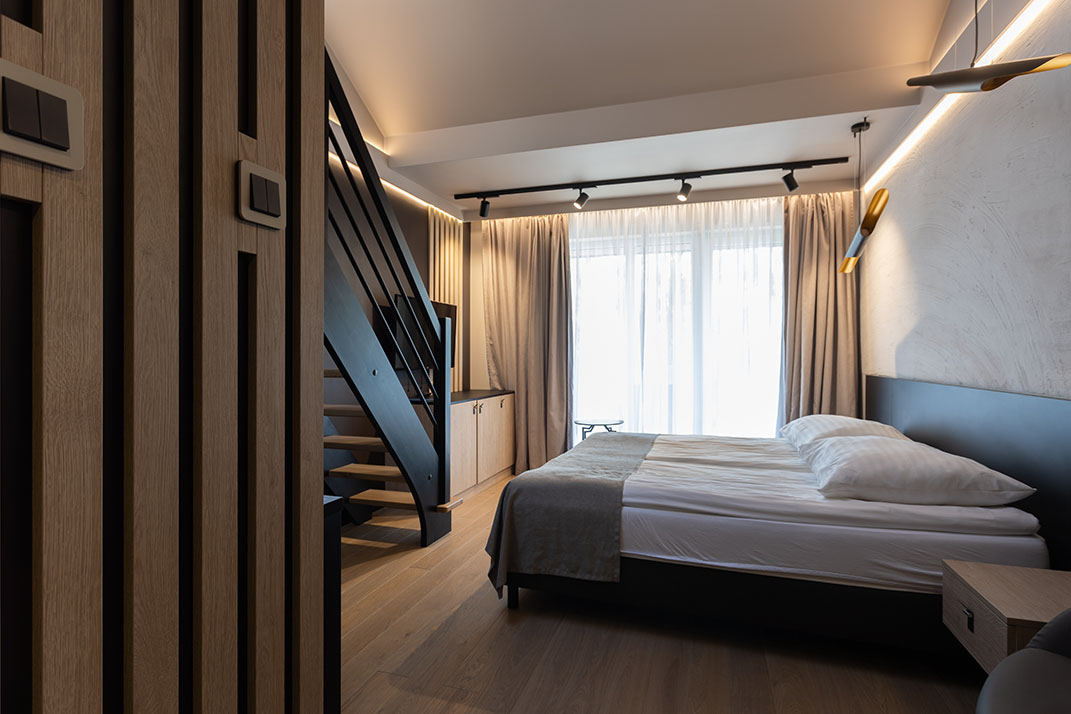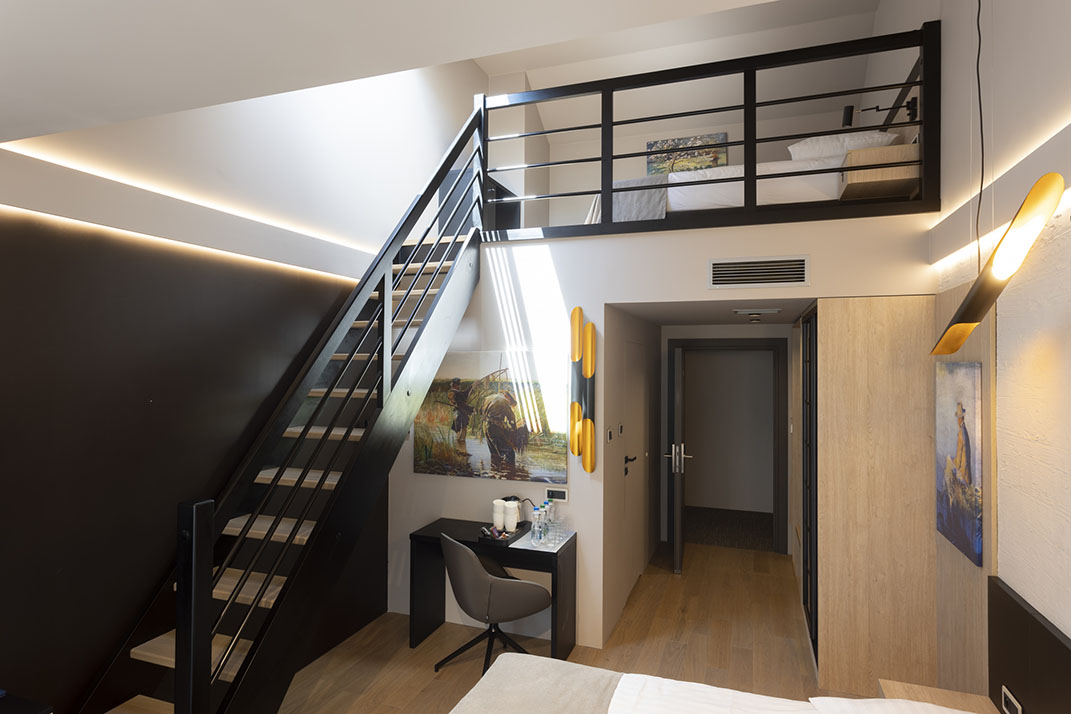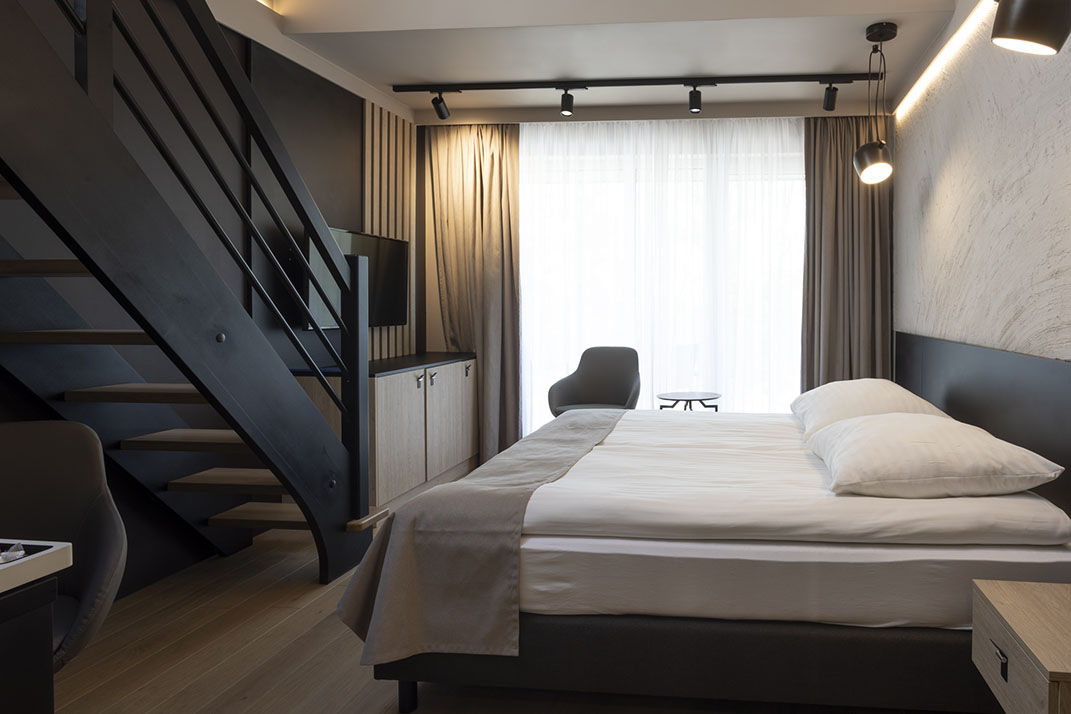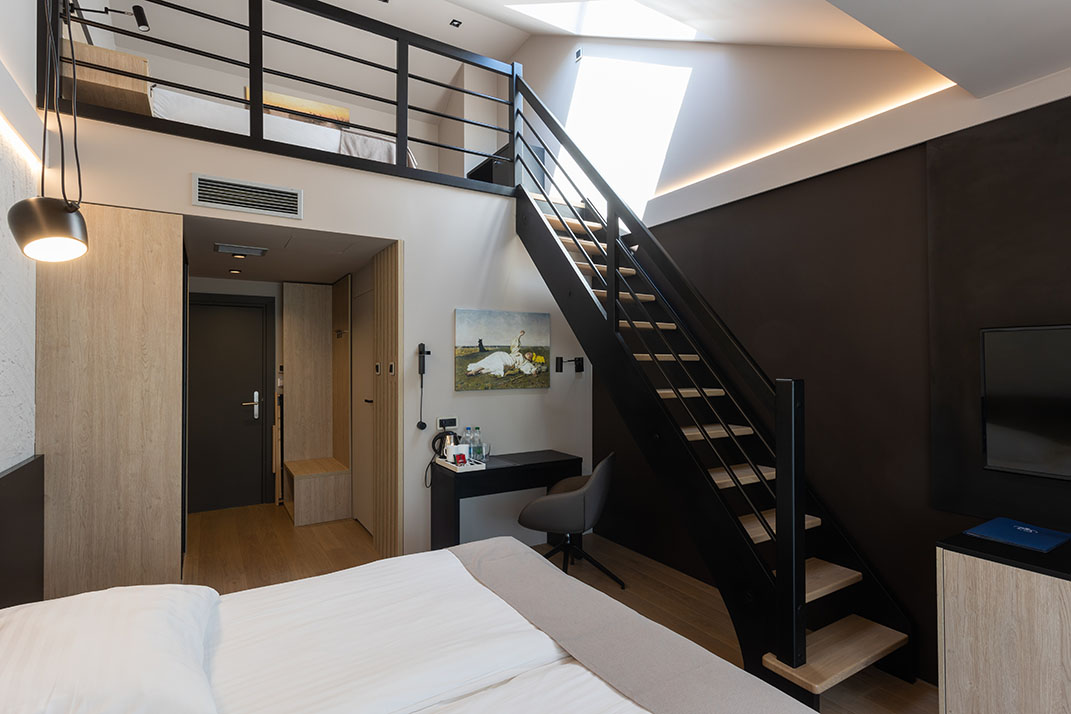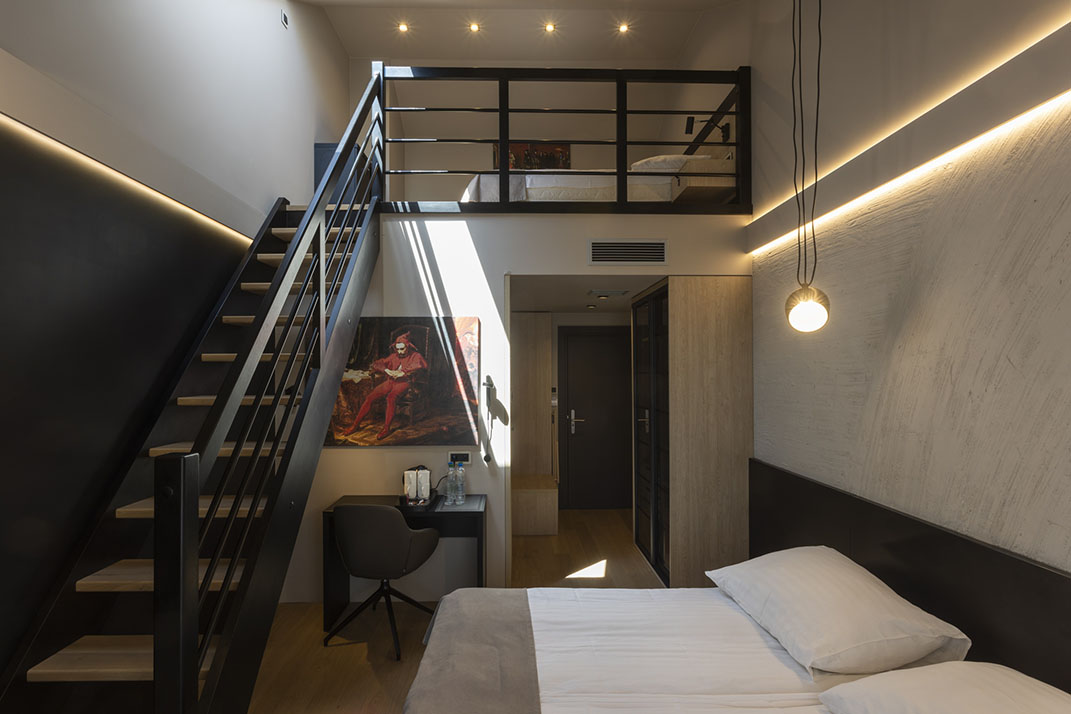Rooms
Spend your holiday at the Four Winds Resort & Spa!
Come and take a break from the hustle and bustle of the city. At Four Winds, you will experience the tranquillity you can hardly find at the Polish seaside all year round. The surroundings are beautiful and unspoilt. The rooms are exceptionally comfortable and modernly furnished. This contrast will make you feel special.
Nikolov I Double room
Economy rooms are located on the 2nd floor in the western part. They are cozy rooms, enriched with slants. Each is equipped with a comfortable 180cm wide bed, minibar, safe, flat-screen TV, air conditioning, welcome kit, hairdryer, as well as towels and toiletries. The room has a bathroom with a shower. Room size is 18-20 sq. m. Extra bed possible by arrangement.
Ivailo Nikolov was born in Bulgaria in 1982.
He is a young artist of unparalleled talent. He graduated from the Academy of Fine Arts in Varna. He worked in Italy for four years together with Athos Faccincani. Through his interpretation of the spirit of fine arts, he imbues his paintings with an expressive richness that is one of a kind. Although each new subject seems to dictate style and approach, he always works with color, light, texture, atmosphere, energy and feeling. His work is referred to as Modern Impressionism (Modern Impressionism). He has gained great popularity, also thanks to the work of photographer Boyan Dimitrov, who faithfully photographed his paintings and made them available to a wider audience. Today, Ivailo Nikolov's works are being snapped up all over the world by individuals, galleries and institutions.
On the walls of the room:
“Sunset”.
Nikolov II Double room
Economy rooms are located on the 2nd floor in the western part. They are cozy rooms, enriched with slants. Each is equipped with a comfortable 180cm wide bed, minibar, safe, flat-screen TV, air conditioning, welcome kit, hairdryer, as well as towels and toiletries. The room has a bathroom with a shower. Room size is 18-20 sq. m. Extra bed possible by arrangement.
Ivailo Nikolov was born in Bulgaria in 1982.
He is a young artist of unparalleled talent. He graduated from the Academy of Fine Arts in Varna. He worked in Italy for four years together with Athos Faccincani. Through his interpretation of the spirit of fine arts, he imbues his paintings with an expressive richness that is one of a kind. Although each new subject seems to dictate style and approach, he always works with color, light, texture, atmosphere, energy and feeling. His work is referred to as Modern Impressionism (Modern Impressionism). He has gained great popularity, also thanks to the work of photographer Boyan Dimitrov, who faithfully photographed his paintings and made them available to a wider audience. Today, Ivailo Nikolov's works are being snapped up all over the world by individuals, galleries and institutions.
On the walls of the room:
“Boats”
Witkacy Double room
Economy rooms are located on the 2nd floor in the western part. They are cozy rooms, enriched with slants. Each is equipped with a comfortable 180cm wide bed, minibar, safe, flat-screen TV, air conditioning, welcome kit, hairdryer, as well as towels and toiletries. The room has a bathroom with a shower. Room size is 18-20 sq. m. Extra bed possible by arrangement.
Stanislaw Ignacy Witkiewicz coat-of-arms Nieczuja, a.k.a. Witkacy (born February 24, 1885 in Warsaw , died September 18, 1939 in Jeziory) - Polish writer, painter, philosopher, playwright and photographer. He laid the groundwork for his artistic theories, published as “New Forms in Painting and the Resulting Misunderstandings,” containing the Theory of Pure Form. Between the wars he became an important figure in cultural and social life. His activities and work were perceived in two ways - he fascinated with his talent and personality, his portraits and representations became extremely fashionable, while at the same time he was considered a frivolous artist, a freak and eccentric, to which his - somewhat shocking - lifestyle and the form of his works, very innovative and for many too avant-garde, contributed.
On the walls of the room
“Portrait of Nena Stachurska” 1930 and
“Temptation of St. Anthony II” 1921-1922
Lempicka Double room
Standard rooms are located on the 1st floor, all have a balcony. Each is equipped with a comfortable 180cm wide bed minibar, safe, flat screen TV, air conditioning, welcome kit, hairdryer, as well as towels and toiletries. The room has a bathroom with a shower. The size of the room is 20 sq. m. One extra bed possible.
Tamara Lempicka (de Lempicka) is a Polish painter of the art deco era. Born as Maria Gurwik-Górska in Warsaw in 1898, Lempicka's style is evident in the pure colors she used, accurate drawing, draperies and shadows. Most associated with Tamara Lempicka are idealized portraits
and nudes with slightly cubic forms and saturated colors. This is especially true of her early period, from which also comes her self-portrait “Tamara in a Green Bugatti,” intended for the cover of Die Dame magazine and considered one of the typical art deco paintings. She died in Mexico in 1980.
On the walls the works:
“Pink Petticoat” 1927 and.
“Saint Moritz” 1929.
Mucha Three-person room
Standard rooms are located on the 1st floor, all have a balcony. Each is equipped with a comfortable 180cm wide bed minibar, safe, flat screen TV, air conditioning, welcome kit, hairdryer, as well as towels and toiletries. The room has a bathroom with a shower. The size of the room is 20 sq. m. One extra bed possible.
Alfons Maria Mucha - czeski malarz i grafik. Urodzony 24 lipca 1860 w miejscowości Ivančice niedaleko Brna. Mucha jest najbardziej znanym przedstawicielem Art Nouveau i fin de siecle'u. W jego twórczości łączą się tradycje bizantyjskie i współczesne elementy. Jego znakiem rozpoznawczym są grafiki kobiet w stylu belle epoque - wyidealizowana postać pięknej kobiety otoczonej naręczem kwiatów i liści, symbolami i arabeskami. Zmarł w Pradze 14 lipca 1939 r.
Na ścianach pokoju prace mistrza:
„Wiosna II" oraz
„Jesień”
Van Gogh Double room
Standard rooms are located on the 1st floor, all have a balcony. Each is equipped with a comfortable 180cm wide bed minibar, safe, flat screen TV, air conditioning, welcome kit, hairdryer, as well as towels and toiletries. The room has a bathroom with a shower. The size of the room is 20 sq. m. One extra bed possible.
Vincent Willem Van Gogh - Dutch Post-Impressionist painter whose work had a far-reaching impact on 20th century art due to its vivid colors and emotional impact.Little appreciated during his lifetime, van Gogh gained fame after his death. Today he is widely regarded as one of the greatest painters in history. Van Gogh began painting a few years before he turned 30, and created his most famous works in his last 2 years. Today, his many self-portraits, landscapes, portraits and sunflowers are among the most recognizable and expensive works of art in the world. He lived from 1853 to 1890.
On the walls of the room the master's works:
“Café Terrace at Night” 1888 and.
“Starry night over the Rhone” 1888.
Nikolov Double room
The Comfort Room is located on the 1st floor, facing the Vistula Lagoon, or south. The room is equipped with a minibar, safe, flat-screen TV, air conditioning, welcome kit, hairdryer, as well as towels and toiletries. . Room has a balcony. The bathroom has a shower. The size of the room is 22 sq. m. One extra bed possible.
Ivailo Nikolov was born in Bulgaria in 1982.
He is a young artist of unparalleled talent. He graduated from the Academy of Fine Arts in Varna. He worked in Italy for four years together with Athos Faccincani. Through his interpretation of the spirit of fine arts, he imbues his paintings with an expressive richness that is one of a kind. Although each new subject seems to dictate style and approach, he always works with color, light, texture, atmosphere, energy and feeling. His work is referred to as Modern Impressionism (Modern Impressionism). He has gained great popularity, also thanks to the work of photographer Boyan Dimitrov, who faithfully photographed his paintings and made them available to a wider audience. Today, Ivailo Nikolov's works are being snapped up all over the world by individuals, galleries and institutions.
On the walls of the room:
“Red light” and
“Autumn landscape”
Nikolov III Four-person room
Room 4 persons Comfort is located on the 2nd floor. It is a medium sized room with a slant. The room has a bathroom with a bathtub. In addition, it is equipped with a minibar, safe, desk, flat-screen TV, air conditioning, hairdryer, as well as towels and toiletries. The room has one double bed (140cm wide) and 2 single beds (90cm).
Ivailo Nikolov was born in Bulgaria in 1982.
He is a young artist of unparalleled talent. He graduated from the Academy of Fine Arts in Varna. He worked in Italy for four years together with Athos Faccincani. Through his interpretation of the spirit of fine arts, he imbues his paintings with an expressive richness that is one of a kind. Although each new subject seems to dictate style and approach, he always works with color, light, texture, atmosphere, energy and feeling. His work is referred to as Modern Impressionism (Modern Impressionism). He has gained great popularity, also thanks to the work of photographer Boyan Dimitrov, who faithfully photographed his paintings and made them available to a wider audience. Today, Ivailo Nikolov's works are being snapped up all over the world by individuals, galleries and institutions.
On the walls of the room:
“Boat and Ocean” and
“Lake in Autumn”.
Renoir Double room
Deluxe Plus Room is located on the 1st floor facing the Vistula Lagoon. This is our largest room. It has a king size bed, a large terrace and bathroom with bathtub, and a sofa bed (120cm wide). In addition, it is equipped with a minibar, safe, desk, flat-screen TV, air conditioning, welcome kit, hairdryer, as well as towels and toiletries. Room size is 30 sq. m.
Auguste Renoir, Pierre-Auguste Renoir - French painter and sculptor. Co-founder and one of the leading exponents of Impressionism. He began his artistic career by decorating porcelain tableware. His painting work focused on portraits of children and women, nudes and still lifes. In a career spanning nearly sixty years, he painted some six thousand paintings. He never dealt with landscape painting as intensively as other Impressionists.
On the walls of the room the master's works:
“Girl in a Straw Hat” 1884 and.
“On the seashore” 1883.
Monet Three-person room
The Deluxe 3-person room is located on the 2nd floor facing the Vistula Lagoon. It is a large, spacious room with a high, slanted ceiling. The room has a bathroom with a bathtub and a view; it has a balcony. There is one double bed 160cm wide, one single bed and a sofa bed (foldable if needed). In addition, it is equipped with a minibar, safe, desk, flat-screen TV, air conditioning, welcome kit, hairdryer, as well as towels and toiletries. Room size is 30 sq. m.
Oscar Claude Monet - Born on November 14, 1840 in Paris. French painter, one of the founders and leading exponents of Impressionism. Claude Monet was in almost every sense the founder of French Impressionist painting, a term derived from one of his paintings “Impression, Sunrise”. Over the years, his work evolved. In later years, it moved closer to abstraction composed of colorful patches. The most important thing for him became light
and the color it brought out. He died on December 5, 1926 in Giverny.
On the walls of the room the master's works:
“Impression, Sunrise” 1872 and.
“Poppies” 1873.
Wyspiański Double room
Deluxe 2-person rooms are located on the 1st or 2nd floor. There is a comfortable bed (180cm wide) and comfortable armchairs. Also equipped with a minibar, safe, desk, 40 inch flat screen TV, air conditioning, welcome kit, hairdryer, as well as towels and toiletries. All rooms in this category have balconies and bathrooms with shower. Room size is 24-25 sqm. One extra bed is possible.
Stanislaw Wyspianski - playwright, poet, stagecraftsman, creator of modern Polish theater. He was born in Krakow on January 15, 1869, and died there on November 28, 1907.
He received a thorough education; after high school graduation, he studied painting at the School of Fine Arts under Jan Matejko. He also enrolled in the Faculty of Philosophy at Jagiellonian University. In May 1891 he went to study in Paris, but was not accepted. So he started painting in one of the Paris studios.
In September 1894, he returned to Krakow. He continued to paint pictures, and also began writing dramas and opera librettos.
Wyspianski practiced very different fields of art, executed with great courage and panache. He drew up plans for the restoration of historical monuments, composed polychrome and monumental stained glass windows for Krakow's Franciscan Church, and designed the layout of the magazine “Life.” He painted paintings and designed furniture, wrote dramas and prepared stage plans. He worked quickly and extremely intensely - his very diverse legacy was created in just over a dozen years of creative life.
On the walls of the room
“Planty at Dawn” 1894.
Boticcelli Double room
Deluxe 2-person rooms are located on the 1st or 2nd floor. There is a comfortable bed (180cm wide) and comfortable armchairs. Also equipped with a minibar, safe, desk, 40 inch flat screen TV, air conditioning, welcome kit, hairdryer, as well as towels and toiletries. All rooms in this category have balconies and bathrooms with shower. Room size is 24-25 sqm. One extra bed is possible.
Sandro Botticelli, actually Alessandro di Mariano Filipepi, was born on March 1, 1445 in Florence. An Italian painter of the Florentine school who worked in the early and mature periods of the Renaissance.
In 1470, at the age of 25, he opened his own studio, where he executed commissions from wealthy Florentine families, while from 1472 he was listed in the Guild of St. Luke as an independent painter.
He spent most of his life in his native Florence, making a few trips, including to Rome, Pisa and probably Mugello. He very quickly found patrons, a family related to the Medici family. Later in his career, he succumbed to the ascetic ideology preached by Savonarola, which significantly influenced his painting style.
Botticelli's style can be described as “poetic”. He was a painter of feminine charm. He created perfect luminosity of robes and used natural decorativeness in the depiction of movement. Features of Botticelli's works also include cool and pure color and precision of drawing.
The painter died in Florence before May 17, 1510.
On the walls of the room
“Birth of Venus” circa 1485.
Gierymski Double room
Deluxe 2-person rooms are located on the 1st or 2nd floor. There is a comfortable bed (180cm wide) and comfortable armchairs. Also equipped with a minibar, safe, desk, 40 inch flat screen TV, air conditioning, welcome kit, hairdryer, as well as towels and toiletries. All rooms in this category have balconies and bathrooms with shower. Room size is 24-25 sqm. One extra bed is possible.
Aleksander Gierymski, born in 1850 in Warsaw, a representative of realism and a precursor of Polish impressionism and luminism. In 1867 Aleksander Gierymski began his studies at the Drawing Class in Warsaw under the direction of Raphael Hadziewicz. He continued his studies at the Academy of Fine Arts in Munich. In 1869 he attended the private studio of Franz Adam. From 1873 to 1874 he stayed in Rome, where his first known paintings were created: the Roman Austeria and the Game of Mora, which were exhibited at the Zachęta in early 1875. From late 1875 to 1879, Aleksander Gierymski stayed in Italy working intensively to perfect his artistic craft.
The most brilliant period of Aleksander Gierymski's work was during the years 1879-1888, which the artist spent in Warsaw. During this period he became associated with a group of young writers and painters from the positivist movement.
Aleksander Gierymski spent the last years of his life in Italy. He probably died on March 8, 1901 in Rome in a hospital for the mentally ill.
On the walls of the room
“Orangery”
“Fishing boats”
Vermeer Double room
Deluxe 2-person rooms are located on the 1st or 2nd floor. There is a comfortable bed (180cm wide) and comfortable armchairs. Also equipped with a minibar, safe, desk, 40 inch flat screen TV, air conditioning, welcome kit, hairdryer, as well as towels and toiletries. All rooms in this category have balconies and bathrooms with shower. Room size is 24-25 sqm. One extra bed is possible.
Johannes Vermeer was born in 1632 in Delft, where he also died in 1675. He was a Dutch painter who was forgotten for many years. It was only in the 19th century that his work was rediscovered. At first Vermeer painted religious pictures, but he became famous as the author of genre scenes. His paintings capture the extraordinary beauty of the everyday life of the bourgeoisie. Vermeer is considered a master of handling light. The artist is credited today with a little over 30 paintings, and this is probably his entire artistic output. Many of them depict women in residential interiors. The heroines of his paintings are often busy reading a letter, talking, weighing pearls. The painter also created landscapes. One of the most famous is the one depicting a view of his hometown, Delft.
Vermeer's paintings inspire and spark the imagination of artists to this day, as exemplified by the book and movie about the mysterious Girl with a Pearl, which the artist portrayed in one of his canvases.
On the walls of the room
“Girl with a Pearl” circa 1665-1666.
Wierusz-Kowalski Double room
Deluxe 2-person rooms are located on the 1st or 2nd floor. There is a comfortable bed (180cm wide) and comfortable armchairs. Also equipped with a minibar, safe, desk, 40 inch flat screen TV, air conditioning, welcome kit, hairdryer, as well as towels and toiletries. All rooms in this category have balconies and bathrooms with shower. Room size is 24-25 sqm. One extra bed is possible.
Alfred Wierusz-Kowalski was born on 11.10.1849 in Suwalki, and died on 16.02.1915 in Munich. He was a Polish painter, creating realistic paintings. He specialized in depicting genre and genre-historical scenes.
He received his first drawing lessons at the Real Gymnasium in Kalisz. He continued his studies in Warsaw at the Drawing Class. Later Kowalski decided to go to Dresden and study at the academy there. In 1872 he went to Prague, where he took up independent work and creation. In the spring of the following year he moved to Bavaria, where he settled permanently. He studied in Munich for a year. After moving there, he also began to achieve his first successes - in 1873 his painting The Return of the Bursar was accepted for the “World Universal Exhibition” in Vienna. Kowalski quickly gained critical acclaim, and his paintings were awarded many medals. In 1890 he became an honorary professor at the Munich Academy. To this day, he is considered one of the most prominent representatives of the
of the so-called Munich School.
On the walls of the room
“Departure by Carriage” 1876 r.
Mucha II Four-person room
Deluxe room for 4 person studio type, dedicated to families with children. Two rooms with a total area of 30 sq m are available to guests; 2 double beds 180 and 120 cm wide, 2 flat-screen TVs, armchairs. Additionally, it is equipped with a minibar, safe, desk, air conditioning, welcome kit, hairdryer, as well as towels and a set of cosmetics. The room has a balcony and a bathroom with a shower.
Alfons Maria Mucha - Czech painter and graphic artist. Born on July 24, 1860 in Ivančice near Brno. Mucha is the most famous representative of Art Nouveau and fin de siecle. His work combines Byzantine traditions and contemporary elements. His trademark are graphics of women in the Belle Epoque style - an idealized figure of a beautiful woman surrounded by an armful of flowers and leaves, symbols and arabesques. He died in Prague on July 14, 1939.
Beksiński Four-person room
1 381 / 5 000
Deluxe rooms for 4 people with a mezzanine dedicated to families with children. Guests have at their disposal a space with a total area of 34 sq m; 2 double beds 180 and 160 cm wide and armchairs. Additionally, it is equipped with a minibar, safe, desk, air conditioning, welcome kit, hairdryer, as well as towels and a set of cosmetics. The room has a balcony and a bathroom with a shower.
Zdzisław Beksiński was born on February 24 in Sanok. An architect by profession, a photographer, graphic designer and painter by choice. As a young artist, he was involved in photography, winning a number of international competitions. The next form of expression for young Beksiński was purely abstract sculpture. After some time, however, he moved on to the next form of expression, which was drawing. Around 1964 he started painting, then he broke with the avant-garde and fully devoted himself to fantastic, visionary, figurative painting, carefully painted with oil paint on fiberboard. He never gave his paintings titles, believing that each viewer could interpret them in any way. Beksiński's paintings were dominated by visions reminiscent of nightmares. After 2000, while continuing to paint and draw, he began to create his compositions on a computer and using a photocopier.
Zdzisław Beksiński was murdered in his apartment in Warsaw on the night of February 21-22, 2005, a few days before his 76th birthday.
Wyczółkowski Four-person room
Deluxe rooms for 4 people with a mezzanine dedicated to families with children. Guests have at their disposal a space with a total area of 34 sq m; 2 double beds 180 and 160 cm wide and armchairs. Additionally, it is equipped with a minibar, safe, desk, air conditioning, welcome kit, hairdryer, as well as towels and a set of cosmetics. The room has a balcony and a bathroom with a shower.
Leon Wyczółkowski was born on April 24, 1852 in Huta Miastkowska in Podlasie. In 1863, he started studying at a junior high school in Siedlce, then in Warsaw. He took up studies in the Drawing Class in the years 1869-1875. He continued his studies in Munich and at the Krakow School of Fine Arts with Jan Matejko. In 1878 he went to Paris for the Universal Exhibition. In 1895, Leon Wyczółkowski became a professor at the School of Fine Arts in Kraków, and in 1909/1910 he was its rector.
He exhibited his works at international exhibitions in Munich, Venice and Vienna. From 1914, he dealt mainly with graphics.
The master was awarded numerous awards, including: the Order of Polonia Restituta, 4th class, the Medal of Honor and the Gold Medal in Paris, the Commander's Cross with Star of the Order of Polonia Restituta, and the Grand Gold Medal. Wyczółkowski also received the Gold Cross of Merit. In 1934, he was awarded the Grand Cross of the Order of Polonia Restituta, and in 1935 he received the Golden Academic Laurel for his services to Polish art.
The artist died on December 27, 1936 in Warsaw of pneumonia and was buried near Bydgoszcz, in accordance with his last will.
On the walls of the room
"Fishermen" 1891
"Fisherman" 1896
"Magnolias" 1905
Chełmoński Four-person room
Deluxe rooms for 4 people with a mezzanine dedicated to families with children. Guests have at their disposal a space with a total area of 34 sq m; 2 double beds 180 and 160 cm wide and armchairs. Additionally, it is equipped with a minibar, safe, desk, air conditioning, welcome kit, hairdryer, as well as towels and a set of cosmetics. The room has a balcony and a bathroom with a shower.
Józef Chełmoński was born on November 7, 1849, near Łowicz. He came from a noble family in which art was highly valued, so in 1867, in Warsaw, he began his artistic education. At the same time, he studied art in Wojciech Gerson's private studio. In 1972, he began a three-year course at the Munich Academy. In 1875 he went to Paris, where his paintings gained enormous popularity. Apart from the capital of France, during his youth he also visited Italy, Podolia and Ukraine. In 1878, he and his wife went on a 10-year journey. At that time, the couple visited and lived in Vienna, Munich, Venice and Paris.
Chełmoński is famous primarily for his landscapes showing the life of Polish and Ukrainian villages. He also became famous for his depictions of animals, including birds (cranes, quails). However, Chełmoński became particularly famous for his depictions of horses, which he showed with extraordinary precision and perspective perfection, rushing from the painting straight towards the viewer.
In 1914, he suffered an attack of apoplexy, which resulted in the paralysis of one hand, and although it was restored, Chełmoński painted nothing more. He died at the age of 64.
On the walls of the room
"Dawn. The Kingdom of Birds” 1906
"Indian Summer" 1875.
Matejko Four-person room
Deluxe rooms for 4 people with a mezzanine dedicated to families with children. Guests have at their disposal a space with a total area of 34 sq m; 2 double beds 180 and 160 cm wide and armchairs. Additionally, it is equipped with a minibar, safe, desk, air conditioning, welcome kit, hairdryer, as well as towels and a set of cosmetics. The room has a balcony and a bathroom with a shower.
Jan Matejko was born in 1838 in Kraków. In 1858, he graduated from the School of Fine Arts there, then studied in Munich and Vienna. Matejko's youthful works already gained international recognition. The artist was hailed as one of the most outstanding creators of historical painting in Europe. He created over three hundred oil paintings and hundreds of drawings and sketches. He is also the author of the polychrome of St. Mary's Church in Krakow. Matejko has repeatedly presented his works at exhibitions, won numerous prestigious awards and distinctions, and became an honorary member of many art academies. In 1873, he was appointed director of the Krakow School of Fine Arts. He held this position until the end of his life. Jan Matejko's students were outstanding creators of Young Poland, including: Stanisław Wyspiański. He died in 1893 in Kraków.
On the walls of the room:
"Stańczyk" Jan Matejko 1862
"Stańczyk" Leon Wyczółkowski 1898
When painting this picture, Leon Wyczółkowski consciously referred to the work of Jan Matejko. Matejko showed the clown as a person concerned about the fate of the then independent Poland, while Wyczółkowski showed the clown reflecting on the fall of the nation now led by conservatives loyal to the invader, whom he gave the form of theatrical puppets.



